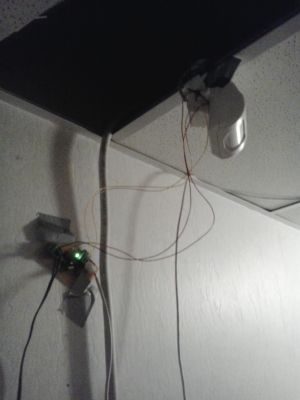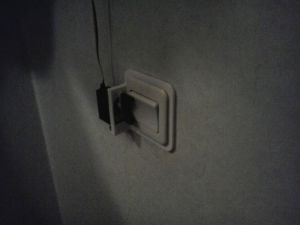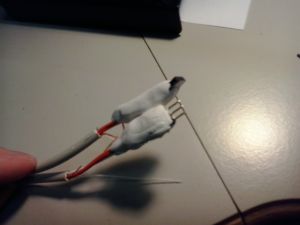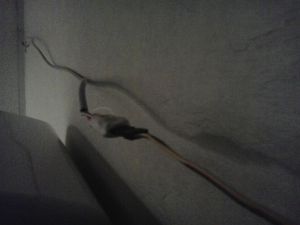Bathroom Light: Difference between revisions
(Created page with "{{Project |ProjectSkills=Soldering, Arduino, 3D Printing, Coding |ProjectStatus=Finished |ProjectNiche=Electronics |ProjectPurpose=Infrastructure }} The bathroom light was com...") |
No edit summary |
||
| Line 5: | Line 5: | ||
|ProjectPurpose=Infrastructure | |ProjectPurpose=Infrastructure | ||
}} | }} | ||
[[File:Bathroom_Board_and_Sensor.jpg|thumb|The finished board mounted on the wall.]] | |||
The bathroom light was commonly left on in the new space. This is ungreen, so a solution to this was desired. The following criteria were desired: | The bathroom light was commonly left on in the new space. This is ungreen, so a solution to this was desired. The following criteria were desired: | ||
| Line 12: | Line 13: | ||
An old motion sensor was present already in the space, so with a bit of screwdriver work and an old wall-wart, a 12V supply for it was found. Also available was an unused servo. This presented the opportunity to place the servo over the light switch and allow for human override. | An old motion sensor was present already in the space, so with a bit of screwdriver work and an old wall-wart, a 12V supply for it was found. Also available was an unused servo. This presented the opportunity to place the servo over the light switch and allow for human override. | ||
[[File:Servo_Lightswitch.jpg|left|thumb|]] | |||
A protoboard arduino-clone was designed and developed and coded to turn off the light after 10 minutes of no activity. It was originally designed to output a serial line, however this seemed to cause the chip to become buggy, so a simple high signal is generated on motion detection. It is voltage divided down to allow for connection to a Raspberry Pi. | A protoboard arduino-clone was designed and developed and coded to turn off the light after 10 minutes of no activity. It was originally designed to output a serial line, however this seemed to cause the chip to become buggy, so a simple high signal is generated on motion detection. It is voltage divided down to allow for connection to a Raspberry Pi. | ||
[[File:Sugru_Servo.jpg|thumb|]] | |||
The board was to be positioned a long way from the switch, so a servo extension cable was bashed up using some Sugru to insulate the plugs neatly. | |||
[[File:Long_Servo_Cable.jpg|left|thumb|The long servo cable on the wall. This might not work for every application, but this worked OK for me!]] | |||
It might not be a good idea to do this yourself, but the low power use on the servo allowed this long cable to work fine here. | |||
Revision as of 22:15, 28 November 2013
| NURDspace Project | |
|---|---|
| Participants | |
| Skills | |
| Status | |
| Niche | |
| Purpose | |
| Tool | |
| Location | |
| Cost | |
| Tool category | |
{{{Name}}}Property "Tool Name" (as page type) with input value "{{{Name}}}" contains invalid characters or is incomplete and therefore can cause unexpected results during a query or annotation process. Property "Tool Image" (as page type) with input value "File:{{{Picture}}}" contains invalid characters or is incomplete and therefore can cause unexpected results during a query or annotation process. {{{Picture}}} {{#if:{{{Tool}}} | [[Tool Owner::{{{ProjectParticipants}}} | }} {{#if:{{{Tool}}} | [[Tool Cost::{{{Cost}}} | }}
The bathroom light was commonly left on in the new space. This is ungreen, so a solution to this was desired. The following criteria were desired:
- No interference with the existing wiring
- No drilling in the walls
- Some means of reporting out the presence/absence of someone using the bathroom (for future expansion)
An old motion sensor was present already in the space, so with a bit of screwdriver work and an old wall-wart, a 12V supply for it was found. Also available was an unused servo. This presented the opportunity to place the servo over the light switch and allow for human override.
A protoboard arduino-clone was designed and developed and coded to turn off the light after 10 minutes of no activity. It was originally designed to output a serial line, however this seemed to cause the chip to become buggy, so a simple high signal is generated on motion detection. It is voltage divided down to allow for connection to a Raspberry Pi.
The board was to be positioned a long way from the switch, so a servo extension cable was bashed up using some Sugru to insulate the plugs neatly.
It might not be a good idea to do this yourself, but the low power use on the servo allowed this long cable to work fine here.




